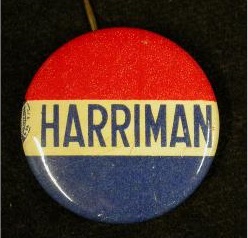Born to immense wealth and privalege, Kathleen Harriman would defy societal expecation and become a witness to some of the 20th century's most prolific history.
Kathleen Harriman, or “Kathy” as she was known to her closest friends, was born into a world of unparalleled wealth and splendor. Her parents were well known in New York’s elite social register. Kathleen’s father, Averell, was the heir to an immense railroad fortune that was valued at around one hundred million dollars. Born in December of 1917, “Kathy” was the youngest of two daughters that came from Kitty and Averell’s troubled union. The two ultimately divorced in 1929. Kathleen attended elite preparatory schools, excelling academically and athletically (she was a gifted skier and equestrian). Intimately acquainted with the pernicious backbiting that was synonymous with New York society, she was also keenly aware of the growing expectation that she would marry into one of the city’s infamous blue blood families. Following her 1940 graduation from college, however, she announced different plans. Her father, Averell, had been recently summoned to London to oversee the Lend-Lease program: and she fully meant to go with him.

Kathleen was apart of a prominent New York family. Her father, Averell, held many offices and even ran for President! Above is a campaign button from his ill-fated run in 1956. New-York Historical Society.
Kathleen arrived with her father in 1941, and was soon mixing with London’s elite. She was a regular guest of the Churchill’s, becoming a special friend to Winston Churchill’s daughter-in-law, Pamela. During this time, Kathleen’s father had a rather infamous affair with Pamela, a relationship that would continue for decades to come. Despite this hectic personal period, Kathy wasn’t overcome by her life’s events: instead she became a news reporter for the International News Service. Doubting at first her capability, she would succeed so greatly that she would move from the INS to Newsweek. Her knowledge of the geopolitical climate would be of great help to her in her next assignment: Kathleen’s father had been appointed Ambassador to Moscow in 1943, and once again she followed him.
Upon the German invasion of Russia in June of 1941, America and Britain were joined in an uneasy alliance with the Soviet Union. Both Roosevelt and Churchill were united in their mutual distrust of Stalin, and for his part, the Soviet Dictator cared little for his Western Counterparts. However, all parties acknowledged that their joint cooperation was necessary for an Allied victory. Averell Harriman’s presence was intended to be a balm amid widespread Western-Russo angst. On Harriman’s part, however, he depended on Kathleen immensely: delegating many diplomatic social obligations to her. Often, she was able to form relationships and gain information that her father would of never been able to pursue in his formal capacity. Kathleen had particular rapour with Soviet Foreign Minister Vyacheslav Molotov and his wife Polina, both titanic figures in the sphere of Russian politics. She like everyone was terrified of Stalin, though was captivated by his ability to be sometimes gracious and charming. Upon the Harrimans’ departure in Moscow, Stalin himself gifted Kathleen with some of his finest horses.
However, undoubtedly Kathleen’s most critical time in Russia was when she visited the gruesome Katyn Massacre Site, recording her observations in letters home and abroad. In Spring of 1940, the upper echelons of Soviet power decided to purge much of Polish “intelligentsia” (including public officials and army officers). Subsequently, more than 20,000 were brutally executed in the forests of Katyn; years later when the mostly-decomposed corpses were discovered the Soviets blamed it on the Germans. It was under this guise that Kathleen was invited to view the “latest discovery” of the Third Reich’s wartime atrocities. The sight was horrific. It was only after the War did Kathleen discover the true perpetrator of Katyn.

Kathleen’s father, Averell, seated second from left along with Churchill, Stalin and Molotov. Library of Congress.
Kathleen left Moscow with her father following the War. And as the Iron Curtain fell across Europe, the curtains also drew to a close on Kathy’s diplomatic career. In 1947 she married (at age 30, unthinkably late at the time,) and lived out the rest of her life in relative peace. However, her most sizable impact was undoubtedly the mountainous volumes of correspondence she left behind. Having such intimate relationships with the most formidable figures of the time, along with first-hand knowledge of one of the period’s greatest atrocities, Kathleen Harriman was a direct witness to arguably the most impactful period in history.
The whole of Kathleen's correspondence is in the Library of Congress.